
We frequently get asked for mind mapping tips and how we implement mind maps. We have decided to share a couple examples of mind maps we have used for the blog so everyone can have a glimpse of how we do it. Below are five examples of mind maps that we have created so you can get an idea on how we do it.
We have a very specific way of blogging – it starts with brain storming and we use mind maps to help us in this process. Before we even start blogging, we first mind map our thoughts, structure them and then write the actual blog post. We have found this to be an effective way of blogging and this post will showcase five examples of blog posts and pages that all started off as a mind map.
The mind maps discussed in the post are created by both Aaron and I. We wanted to keep this post fairly simple for all new mind mappers out there. Thus all mind maps are pretty straight forward. I assume in this post that you know the basics of mind mapping. If you are completely new to mind mapping and you need a quick primer, I highly suggest that you first read our mind mapping page.
All mind maps are available in a zip file that you can download here. Since all mind maps are created by Mindjet MindManager (click here for Mac or Windows) you will need this software to read and edit these files.
So with that all out of the way, let’s get to the actual mind maps.
1. Brainstorm Mind Map
One good use of mind mapping is for brainstorming. It’s a great way to grab those free flowing thoughts and to not worry about semantics, structure or if it even makes sense.
As an example, here is a brainstorm mind map of mine when I wrote about Eat That Frog by Brian Tracy. It was my first iteration and it was not modified at all after my brainstorm session. When I wanted to write about the book, I sat down, fired up MindManager, and I started to brainstorm on what I would write about. This is the result.
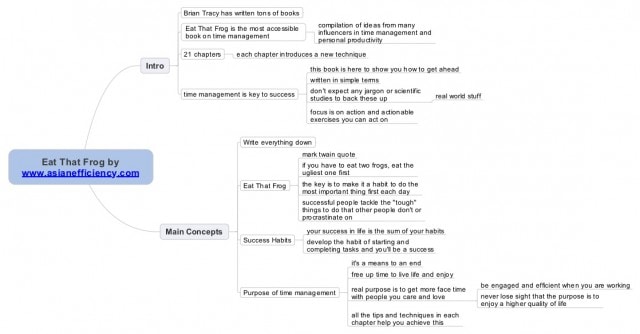
When you really know your topic then your mind map will be fairly complete when you first create it. This was the case with Eat That Frog since I know the book inside-out. However, when you don’t know your topic that well your mind map will usually go through multiple iterations and that is totally fine.
2. A Long List
Mind maps can great great for compiling lists just like text notes. One advantage mind maps have over text notes is that it is visually represented – you can scan it faster and you can memorize it better.
A great example of this is our post on essential iPhone apps. It’s a simple list that has categories and without much depth – just like how a good list should be.
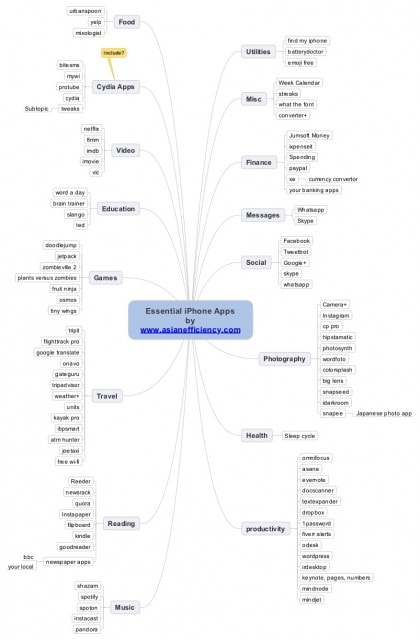
Pretty straight forward, right?
3. Simple Mind Map
The next example is the mind map Aaron created about Leverage Points. You will notice that this mind map has a little more depth as indicated by the number of sub-branches.
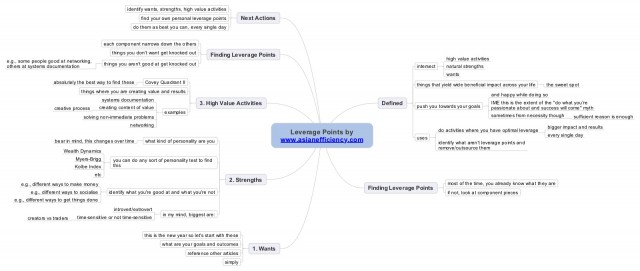
If you are new to mind mapping, the best way to start reading a mind map is by starting at one o’clock and then start working your way down clockwise. This is a recommended practice and for most mindmapping software when you create your first node it usually starts at the one o’clock position. In this mind map you can see that the main definitions are shown before any specifics are mapped out as you read the mind map clockwise.
4. In-depth Mind Map
It’s time to spice it up a little with a more in-depth mind map. The next one is a mind map I created about Covey’s quadrant and you will notice a lot more depth as indicated by the number of sub-branches.
It might seem overwhelming but remember the starting point for any mind map: start reading at one o’clock and work your way around clockwise.
Once you do that, this mind map should not be that intimidating at all.
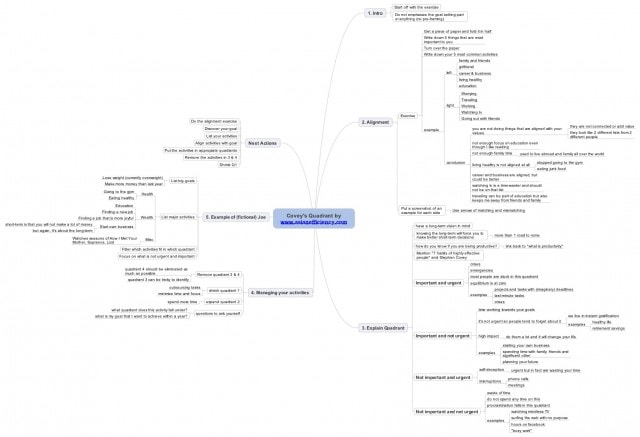
5. Big, overwhelming and in-depth
I’ve decided to save the best for last because it’s a very big mind map. Aaron created this one as he was writing the article series on Agile Results and this mind map was a result of that.
This mind map is a really good example of how you can use mind mapping to plan things ahead. Aaron started to plan ahead the articles he needed to write by breaking down how he uses this productivity system, and then he re-organized it into different articles as indicated by each node. This mind map is the end result of hours of planning, reverse engineering and organizing.
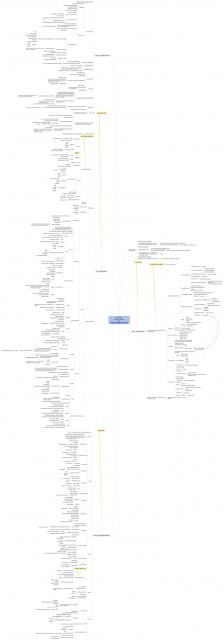
When you first look at it, you will notice it’s quite big. Just because it’s big does not mean it’s harder to read or more complex – it’s just bigger because it contains more information. As you start reading this mind map it should be fairly straight forward and you will notice that it is actually not that overwhelming than when you first looked at it. If you have some experience with mind mapping, then you will notice it’s actually quite impressive. But we’ll leave that call up to you to make :-)
More mind maps
That wraps up this post! I hope you got a lot out of our mind maps and in the near future we will be posting more examples of our mind maps. This post contained fairly simple mind maps but we will show you another time examples of more complex mind maps that we have used at Asian Efficiency.
If you want to play around with our mind maps, you can download all the mind maps here in a zip file. You will need Mindjet MindManager for Mac and Windows to read or edit these files.
If you want to learn more about mind mapping, check out our page on mind mapping.
Photo by rainerstropek.

I find mind maps most useful while I’m actively creating them. Like you said, they get ideas flowing. Unfortunately, I don’t find much use for them afterwards. I don’t tend to go back to them to review. And of course, without reuse, one forgets. Why don’t I go review them? It’s awkward for me. I am extremely finicky about the relationship of the branches making sense. When going back to mind map, I notice all the flaws and illogical branching which makes the process less engaging. I find mind maps better for brainstorming, a kind of a disposable form of mapping. For something more reusable and for memorization, I prefer flash cards like mnemosyne.
I really appreciate mind maps, but have not made them a habit, yet.
I have one question, though…
When you start at One o’clock and work your way around clockwise, doesn’t this resemble a standard outline format?
If that is the case, then is it the methodology and/or the layout of the page that makes the difference? E.g. being able to see the whole document (if not too big) makes it easier to make connections or expand on branches.
Thanks!
Hey Nivesh – indeed if you follow it clockwise it’s similar to a standard outline. The advantage mind maps have is that it is graphical (allows faster scanning and it’s easier to remember) and that you can have relationships among branches that indicate references.
I appreciate your article’s emphasis on the utility of mindmaps. What caused me difficulty was trying to figure out ways to print mindmaps similar to the last mindmap in your article which was “big”. “Big” mindmaps were too unwieldy to work with and too tiny to read when printed, unless printed over several pages and patched together.
Yes, that is a problem. If you want to carry around mindmaps and shows them, I suggest using a tablet. It also saves you paper.